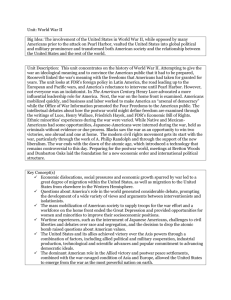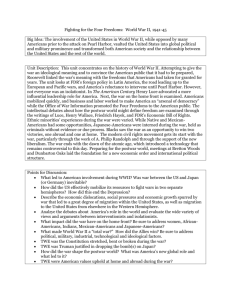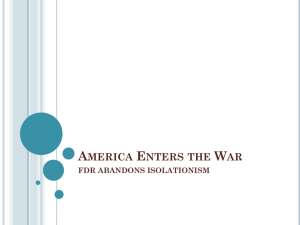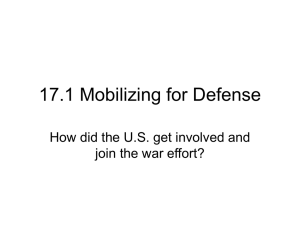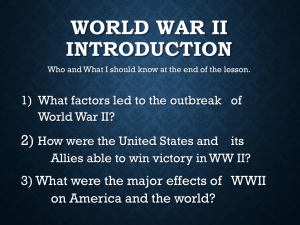Executive Order 9066
advertisement
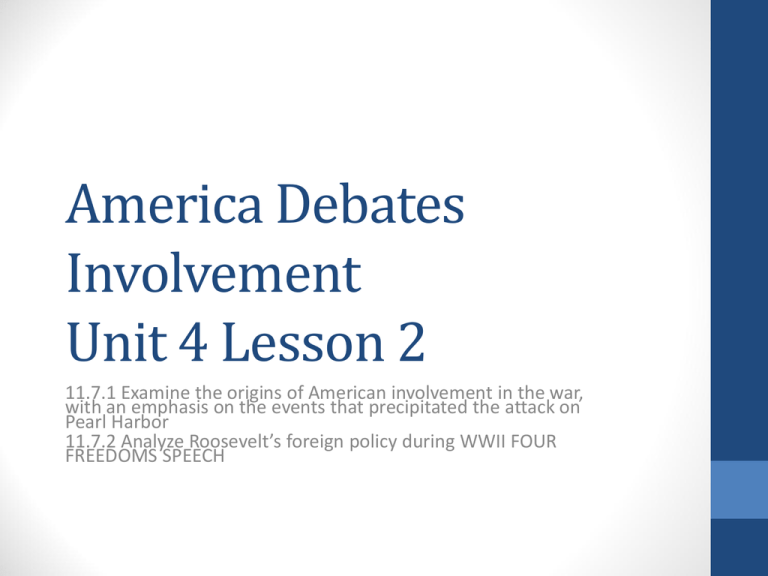
America Debates Involvement Unit 4 Lesson 2 11.7.1 Examine the origins of American involvement in the war, with an emphasis on the events that precipitated the attack on Pearl Harbor 11.7.2 Analyze Roosevelt’s foreign policy during WWII FOUR FREEDOMS SPEECH Vocabulary 1. 2. 3. 4. 5. 6. 7. 8. 9. 10. 11. 12. 13. Isolationism Interventionism Winston Churchill Neutrality Act 1939 Tripartite Pact Lend-Lease Act Atlantic charter Hideki Tojo Pearl Harbor WAC Douglas MacArthur Bataan Death March Battle of Coral Sea 14. A. Philip Randolph 15. Executive Order 8802 16. Executive Order 9066 Focus Questions 1. Examine FDR’s Quarantine Speech. Identify what he is willing to do and provide a hypothesis at to why 2. Why did people move during WWII? 3. What problems occurred because of the migration? 4. How did the federal government control resources needed for the war effort? 5. How did the media help in the war effort? Japanese Aggression • • • • 1937 Japan attacks China Shocked Americans Rape of Nanking FDR Oct. 5, 1937 critical of Japan’s aggression “Quarantine Speech” Oct. 5, 1937 • “When an epidemic of physical disease starts to spread, the community against the spread of disease…. War is a contagion, whether it be declared or undeclared. It can engulf states and peoples remote from the original scene of hostilities. We are determined to keep out of war, yet we cannot insure ourselves against the disastrous effects of war and the dangers of involvement Reaction • This speech signaled to isolationists that FDR is willing to go to war. • This angered many people. • FDR then backed off his interventionist stance Isolationists v. Interventionists • Want neutrality • Congress passes Neutrality Act of 1939 • Interventionists not pleased Four Freedoms speech • • • • • After REELECTION, FDR increases his support for Britain. Why AFTER THE ELECTION? Jan. 6, 1941, addressed Congress “Four Freedoms Speech” Freedom of speech, worship, from want and from fear. Four Freedoms Speech • Who was threatening our four freedoms? • Nazi Germany and Japanese militarism • Best way to stay out of war was to help Britain. Tripartite Pact • Nightly broadcasts about the dire situation in London • Many Americans begin to believe U.S. should prepare to defend itself • Sept. 1940 France falls • Germany, Italy, Japan sign Tripartite Pact reaction • • • • Congress debates isolationism v. interventionist Selective Service Act passes Increase in reserve troops FDR give Britain WWI battleships Result • • • • Lend Lease Act Three months after the speech passed “sell, transfer title to, exchange, lease to” Who ever FDR thought it was necessary to in the interests of the defense of the USA. Atlantic Charter • Aug 1941 • Atlantic Charter • Solidified the relationship between the U.S. and Great Britain Pearl Harbor 11.7.1 Examine the origins of American involvement in the war, with an emphasis on the events that precipitated the attack on Pearl Harbor Problems in Pacific Empire for Japan We stopped selling oil, rubber and other goods to stop their goal for an empire Saw U.S. as intervening FDR signed and embargo in 1940 What been Japan doing? EXPANDING Rape of Nanking Invasion of Manchuria Taking over Philippines The need RAW GOODS! War Begins Pearl Harbor – December 7, 1941 Results 2,500 dead 8 battleships severely damaged 6 cruisers destroyed 288 planes damaged or destroyed US Declares War on Japan Germany and Italy declare war on US Gearing up for War More than 16 million Americans served in the military during WWII Minorities Nearly 1 million African Americans 300,000 Mexican Americans 25,000 Native Americans Women’s Army Corps (WAC) created in 1943 Clerical workers, truck drivers, lab techs, etc.. Women Go to Work Women go to work in White Collar jobs and in factories with Heavy Machinery For the first time middle class American families have 2 working parents (making child care provided by gov’t necessary) Many women did not leave the workforce at the end of the war Rosie the Riveter seen as the icon Early Battles Guam, Wake Island, and Hong Kong taken quickly Philippines attacked December 22 under General MacArthur MacArthur ordered evacuation but 75,000 Allied troops held out in Bataan until May 1942 Bataan Death March -Troops forced to march for 63 miles, killing 7000 Allies try to strike back By summer of 1942 – Japan controlled Indian Ocean and half the Pacific. Colonel James Doolittle leads raid on Japan killing 50 people and destroying 100 buildings Battle of the Coral Sea May 7 and 8, 1942 1st sea battle where ships couldn’t see each other Fought using aircraft, giving advantage to US due to production capacity Allies Turn the Tide America pursued victory in Europe before the Pacific Japan attacked at Midway – the last large US base West of CA Arthur Nimitz (commander of US Navy in Pacific) found out and sent aircraft carriers to Midway US lost 1 carrier Japan lost 4 Carriers including 250 of their most experienced pilots Americans Take the Offensive 1st offensive took place at Guadalcanal in the Solomon Islands in June 1942 After 3 months US forces won US Navy, Marine, and Army forces worked in both the southwest and central Pacific forcing Japan to fight on two fronts US began fighting towards Japan using the Island Hopping technique WWII on the Home Front 11.7.5. Discuss the constitutional issues and impact of events on the U.S. home front, including the internment of Japanese Americans (e.g., Fred Korematsu v. United States of America) and the restrictions on German and Italian resident aliens; the response of the administration to Hitler’s atrocities against Jews and other groups; the roles of women in military production; and the roles and growing political demands of African Americans Women Work for Victory • Women found jobs in heavy industry • (they break a sweat!) • Women didn’t quit because they were married anymore • ¾ women were married • 60% were older than 35 African Americans • A. Philip Randolph fought for the “Double V” – Victory against fascism – Victory against discrimination Executive Order 8802 • Executive Order 8802 – assured fair hiring practices in any job funded with gov’t $. Created Fair Employment Practices Commission • NAACP grew to 50,000 members and others started fighting for equal rights with non-violent protests Population Shifts • African Americans move to factory cities in North like Detroit, Chicago, and Cleveland • Bracero program legally brought Mexican immigrants to work in California Migration Triggers Conflict • Summer of 1943 – Detroit has racial riots starting in a park 34 end up dead • Mexican-Americans attacked in Los Angeles during the Zoot Suit Riots Civil Liberties Restrictions • Aliens from Axis powers forced to register and millions were deported • 11,000 German immigrants and hundreds of Italians were held in Camps • Japanese faced internment due to Executive Order 9066 Executive Order 9066 • Many lost their homes and businesses. • Japanese faced harsher times because: – there were fewer – had less political clout – were relatively isolated Government & Economy • Gov’t spent almost 90% of budget on WWII • Raised $ by implementing a 5% tax on all workers • Citizens also bought war bonds $ $ $ $ $ Rationing • As more goods were sent to soldiers for the war, consumer goods were hard to find • People were rationed and used coupon books to get goods • Black markets were created $ $ $ $ $ Media boosts morale • Office of War Information • Spotlighted common needs • minimized racial and economic divisions • downplayed problems of poverty and crime • Radio, print, and film were patriotic and reminded everybody that we were in a war between democracy and dictatorship • People planted victory gardens, collected scrap metal, and paper.

